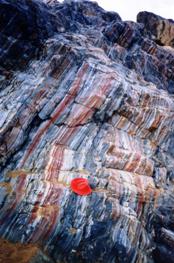
It has long been widely accepted that the Earth’s atmosphere and oceans contained little or no oxygen at any time prior to the so called ‘great oxygen event’ between 2300 and 2200Ma
1,2. However, significant levels of free oxygen have recently been recognised in the Neoarchaean, so the question arises: “when did significant levels first appear?”
3. Oxygen was probably produced by photosynthetic organisms - of which only bacteria were likely to have been extant in the Neoarchaean. The evidence for oxygen comes from organic carbon, microfossils(?) and stromatolites. The suggestion is that such bacteria existed right back to about 3500Ma. Once formed, the oxygen could have been removed by a variety of agencies and reactions, and the level might have fluctuated.
Hoashi
et al 4 have now reported drilling to >200m depth, beyond the depth of present-day near-surface oxidation, in the Marble Bar Chert member of the Duffer Formation, Pilbara, Western Australia (as part of the Archaean Biosphere Drilling Project (ABDP)). The red beds (picture) in this on-end member contain very fine haematite, taken as evidence of oxygen’s being present at the time of deposition in the ocean.
The drilling shows that the haematite does continue below the deepest intersection. The haematite is in the red chert , which is concentrated in the upper part of the member: the black chert forms veins that intrude the white and red chert, but not the overlying Apex basalt, dated at ~3460 Ma. Therefore all three types of chert formed before the basalt eruption at ~3460 Ma, during deposition and diagenesis. The haematite forms very small crystals and neither siderite nor magnetite show evidence of oxidation. Hickman
3, who has had a long career deciphering Pilbara rocks, believes that the depositional environment in the Marble Bar Member changed from anoxic/sideritic, when siderite was deposited, to oxic/haematitic (when haematite and magnetite formed up to 10%), and that the minerals were precipitated close to hyrdothermally active volcanic vents, the basin being successively flooded by water of a different composition. He hypothesises a caldera situation.
This new research seems to have established that the haematite is a primary precipitate, not an oxidation product of magnetite or siderite – which means that oxygenated sea-water was then in existence. Whether it established that cyanobacteria were extant seems beside the point: the famous putative cyanobacteria at North Pole in the Pilbara have been questioned
5 and even said to be inorganic; though the presence of stromatolites there and elsewhere of this great age seems to be well established and the Neoarchean in the Pilbara is riddled with them.
Though Professor Malcolm Walter has very reasonable reservations about the Marble Bar evidence (for the existence of cyanobacteria) because these rocks are so ancient and altered5, this research does seem to establish that there was at least local oxidation of sea water, at least from time to time during the early Archaean. Whether this, even if possibly related to bacteria, was of global significance remains questionable.
Joe McCall